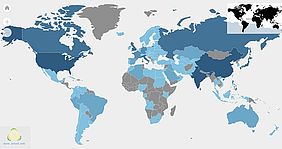Times Higher Education (THE) is a weekly magazine based in London, which publishes information and news related to higher education. It has gained recognition for releasing annual university rankings - the Times Higher Education World University Rankings, and first appeared in November 2004.
This year’s rankings, the Times Higher Education World University Rankings 2021, comprise more than 1,500 universities throughout 93 countries and regions. The lists are based on 13 indicators that evaluate the performance of an institution in four areas: teaching, research, knowledge transfer and international outlook. For the 2021 table, more than 80 million citations in over 13 million research publications have been analysed, and include survey responses from 22,000 scholars globally.
The engineering subject table uses the same performance indicators as the general Times Higher Education World University Rankings, but the methodology has been adapted to suit this particular field. The ranking highlights universities that are leading across the following disciplines: general engineering, electrical and electronic engineering, mechanical and aerospace engineering, civil engineering and chemical engineering. The table includes 1,098 universities, up from 1,008 last year. For the complete 2021 rankings, please visit the homepage of Times Higher Education.
In 2021, the engineering ranking is topped by Harvard University for the first time, while the University of Oxford occupies 2nd position, climbing three places. Harvard University is named among the most prestigious universities in the world and also part of the Ivy League, a group of eight highly-regarded private universities in the US. Established in 1636, it is the oldest university in the country. The institution is associated with more than 45 Nobel laureates, at least 30 heads of state and 48 Pulitzer Prize winners. Harvard can look back on a long history of outstanding research and innovation, including in the fields of energy efficiency, battery science and CO2 capture. Oxford, meanwhile, is one of the oldest universities worldwide and has educated a wide range of notable alumni, including 28 prime ministers of the United Kingdom and many heads of state and government around the world. It also boasts 72 Nobel Prize laureates. At Oxford Energy, one of its numerous research institutions, the university tries to solve some of the most pressing issues of modern energy production. One of its projects, for example, focuses on developing robust, low maintenance, low-cost energy technologies (energy crops) for use in hot, arid areas. Other projects deal with biogas production from crop waste by improved anaerobic digestion, on- and off-grid use of gas, water and ethanol separation, and catalysts for the production of methane and hydrogen.
Places 3 and 4 are claimed by Stanford University and the Massachusetts Institute of Technology (MIT). Stanford is a private research university and hosts, among others, the Precourt Institute for Energy where researchers explore a wide range of promising technologies and policy options to improve the efficiency of, for example, solar energy through high-efficiency photovoltaic devices or to advance biofuel production from wastewater or cellulosic biomass.
The University of California, Berkeley, which has joined the top 10 for the first time, is positioned in 5th place, climbing up from 14th last year. Another newcomer in the top 10 is Peking University, which is in joint 9th position alongside ETH Zurich. The sixth place was awarded to the University of Cambridge, which has dropped three positions this year. The University of California, Los Angeles and the Georgia Institute of Technology have dropped out of the top 10, occupying places 11 and 12, respectively. The highest-ranked newcomer is Paris-Saclay University, which has entered the ranking in the 126-150 band.
In spite of its success story, the University of Oxford, the UK's status as a higher education superpower, might soon be under challenge as institutions from Asia – such as Peking University (9th position), the National University of Singapore (12th position), the Nanyang Technological University, Singapore (15th position), and Tsinghua University (16th position), continue to claim an increasing number of spots at the top end of the ranking. The excellent performance of Asian universities could also impact the ranking of US universities in future, even if the US still commands the highest number of institutions (6) in the top 10.
In total, US universities occupy 11 of the top 20 positions, whereas the other positions are claimed by three UK institutions, four Asian universities, and two Swiss universities. No other European institutions have managed to secure a spot.
